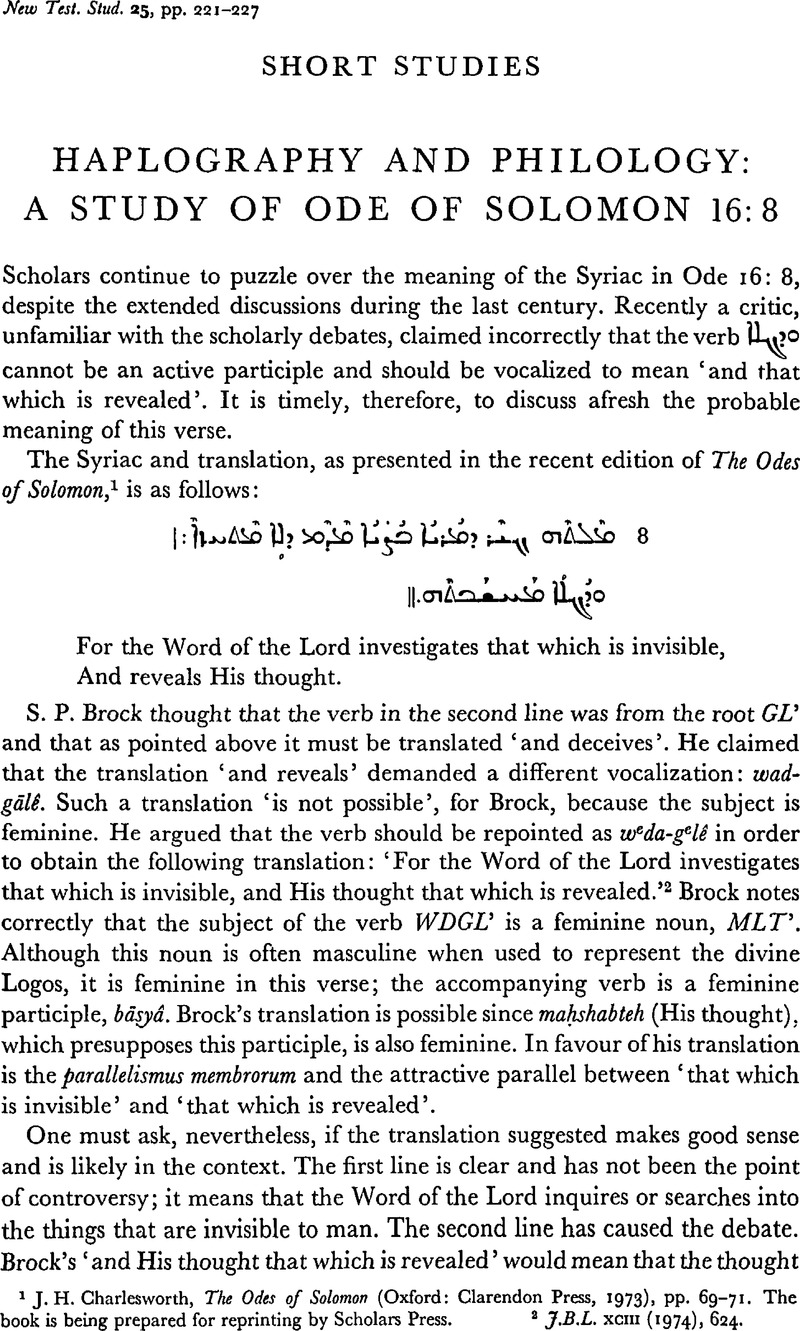No CrossRef data available.
Article contents
Haplography and Philology: A Study of Ode of Solomon 16:8
Published online by Cambridge University Press: 05 February 2009
Abstract

- Type
- Short Studies
- Information
- Copyright
- Copyright © Cambridge University Press 1979
References
page 221 note 1 Charlesworth, J. H., The Odes of Solomon (Oxford: Clarendon Press, 1973), pp. 69–71. The book is being prepared for reprinting by Scholars Press.Google Scholar
page 221 note 2 J.B.L. 93 (1974), 624.Google Scholar
page 222 note 1 We could object by asking why the Odist should make sense. The proper response, of course, is that to presume otherwise is fruitless.
page 222 note 2 Labourt, J. and Batiffol, P., Les Odes de Salomon (Paris: Lecoffre, 1911), p. 17.Google Scholar
page 224 note 1 Parentheses denote words initially omitted by the copyist; brackets circumscribe the attempted restoration.
page 224note 2 The Odes and Psalms of Solomon (Manchester: University Press; New York: Longmans, 1920), 11, 284 f.Google Scholar
page 224 note 3 Lexicon Syriacum (Göttingen: Niemeyer, 1928), p. 141.Google Scholar
page 225 note 1 Thesaurus Syriacus (Oxford: Clarendon Press, 1879)Google Scholar, col. 820. He recorded that DGL in the Peal means ‘levit’, ‘illevit’, ‘decepit’, ‘mentitus fuit’, but failed to note that it also means ‘examinavit’. L. Costaz also recorded only that DGL in the Peal denotes ‘to direct (the dart), to aim at’. Diction-naire Syriaque–Français; Syriac–English Dictionary (Beirut: Catholique, 1963), p. 58Google Scholar. The additional meaning of DGL is not recorded in the supplements to the Thesaurus: Margoliouth, J. P., Supplement to the Thesaurus Syriacus (Oxford: Clarendon Press, 1927)Google Scholar; Schleifer, J., ‘Berichtigungen und Ergänzungen zum Supplement des Thesaurus Syriacus’, Orientalia, n.s. 8 (1939). 25–58.Google Scholar
page 225 note 2 Lexicon Syropalaestinum (Berlin: Reimer, 1903), p. 42.Google Scholar
page 225 note 3 A Compendious Syriac Dictionary (Oxford: Clarendon Press, 1903; repr. 1957), p. 83Google Scholar. DGL is listed as meaning only ‘to falsify, outwit, scheme, be cunning’ in Drawer, E. S. and Macuch, P., A Mandaic Dictionary (Oxford: Clarendon Press, 1963), p. 102.Google Scholar
page 225 note 4 Vocabularium Syriacum (SPIB 110; Rome: Pontificium Inst. Bibl., 1956), p. 39. Idem, ‘Addenda ad Vocabularium Syriacum, Romae 1956’, Orientalia, n.s. xxxix (1970), 315–19.
page 225 note 5 A Syriac–English Glossary (Wiesbaden: Harrassowitz, 1970), p. 15.Google Scholar
page 225 note 6 Gelb, I. J. et al. , The Assyrian Dictionary (Chicago: Oriental Institute; Gluckstadt: Augustin, 1959), III, 21–5Google Scholar. The brilliant Semitist G. R. Driver has noted recently the importance of Accadian (= Assyrian) for an understanding of the Odes; ‘Notes on two passages in the Odes of Solomon’, J.T.S. n.s. 25 (1974), 434–7.Google Scholar
page 225 note 7 Wright, W., A Short History of Syriac Literature (London: Black, 1894; repr. Amsterdam: Philo, 1966), pp. 42 f.Google Scholar
page 225 note 8 The translation is by Harris–Mingana. For more of the Syriac and translation see their The Odes, 11, 285.
page 225 note 9 (Giessen: Töpelmann, 1911), p. 39, 17.
page 225 note 10 Le Odi di Salomone (Rome: Ferrari, 1914), p. 187.Google Scholar
page 225 note 11 The Odes, 11, 285.
page 225 note 12 In the new edition to be published by Scholars Press I have corrected ‘it reveals’ to ‘it perceives’. Even though dagālu in Accadian (= Assyrian) can mean ‘to hand over’ (especially in legal and covenantal relationships), I erred in thinking DGL in the Peal could be stretched to mean ‘exposes’ or ‘reveals’. ‘Perceives’ is preferable to ‘scrutinizes’ (Harris-Mingana); The Word of the Lord would not need to examine the thought of the Lord. I am tempted to restore the text since the only extant manuscript bears ample signs of haplography. Perhaps it is wise to be conservative since a text should receive an emendation only when it is incomprehensible without it.
page 226 note 1 The Odes and Psalms of Solomon (Cambridge: C.U.P. 1909), loc. cit. [A copy was unavailable when I attempted to supply the page number.]
page 226 note 2 The Odes and Psalms of Solomon (second edition, Cambridge: C.U.P. 1911), p. 111.Google Scholar
page 226 note 3 Flemming, J. and Harnack, A., Ein jüdisch-christliches Psalmbuch aus dem ersten Jahrhundert (TU 35.4; Leipzig: Hinrichs, 1910), pp. 45 f.Google Scholar
page 226 note 4 Die Oden Salomos (Heidelberg: Winters, 1911), pp. 38 f.Google Scholar
page 226 note 5 The Odes of Solomon (TS 8.3; Cambridge: C.U.P. 1912), p. 80.Google Scholar
page 226 note 6 J.B.L. 93 (1974) 624.Google Scholar
page 226 note 7 Naissance des lettres chrétiennes (Paris: Editions de Paris, 1957), p. 40.Google Scholar
page 226 note 8 J. Labourt, Les Odes, p. 17. I have placed his translation in parallel lines according to the rules of Semitic poetry. This form has become standard for the Odes ever since R. H. Charles' dictum that nothing less would suffice (‘A Church Hymnal of the First Century’, Times Literary Supplement 430 [7 April 1910], p. 124).
page 226 note 9 Das Verständnis, p. 17.
page 226 note 10 Les plus anciens cantiques chrétiens (Paris: Fischbacher, 1912), p. 57.Google Scholar
page 227 note 1 Le Odi, p. 187.
page 227 note 2 ‘Die Oden Salomos’, Neutestamentliche Apokryphen, second edition, edited by Hennecke, E. (Tübingen: Mohr, 1924), p. 452.Google Scholar
page 227 note 3 Die Oden Salomos (Kleine Texte 64; Berlin: Gruyter, 1933), p. 33Google Scholar. Reprinted with an expanded note in Hennecke, E. and Schneemelcher, W. (eds.), Neutestamentliche Apokryphen (Tübingen: Mohr, 1964), 2, 596.Google Scholar
page 227 note 4 The Oldest Christian Hymn-Book (Temple, Texas: M. MarYosip, 1948), p. 59.Google Scholar
page 227 note 5 The Odes, pp. 69, 71.
page 227 note 6 Note that in Accadian (= Assyrian) DGL can mean ‘to hand over’. It is possible that DGL in the Peal in Syriac also denotes ‘to communicate’ or ‘to make clear’.
page 227 note 7 Les Odes, p. 1.




